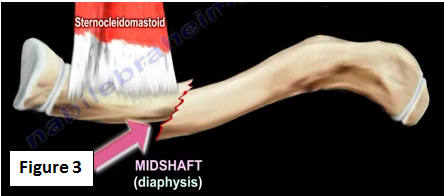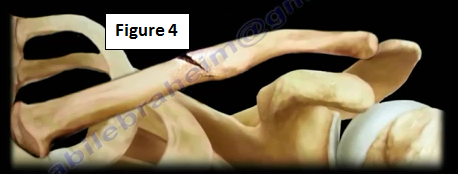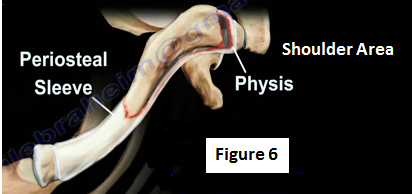A fractured clavicle in children usually heals with a small bump and will remodel in time. The clavicle is the first bone to ossify. The shaft of the clavicle ossifies in membrane and not in cartilage from the two primary ossification centers (Figure 1).
Clavicle Fracture Types
95% of birth related injuries involve the clavicle. A clavicle birth fracture is usually associated with breach delivery and large babies. The fracture may cause pseudoparalysis. The doctor will need to rule out a brachial plexus injury. The reflexes remain intact following an isolated clavicle fracture.
Clavicle Fractures in Children
About 85% of clavicle fractures in children occur in the midshaft (Figures 2A, 2B, and 3). The majority of fractures occur from falls in younger aged individuals or from sports related in older children. When the fracture occurs in the diaphysis, it usually heals with minimal deformity. There will be excellent healing in 6 weeks, with return to non-contact sports. In three months, the patient will be able to return to contact sports.
A green stick fracture is an incomplete fracture in which the bone is bent. Diaphyseal green stick fracture of the clavicle is a common type of fracture (Figure 4). Greenstick fractures have excellent remodeling and always heal without clinical problems.
Fracture of the proximal clavicle occurs in children with an open physeal growth plate (Figure 5). Most of these injuries are classified as Salter-Harris I or II. Posterior dislocation of the clavicle may warrant reduction due to associated complications. If the proximal fracture is displaced posteriorly, an indent is evident. This fracture may cause difficulty in swallowing and breathing. If the proximal fracture is displaced anteriorly, the proximal end is palpable.
When the fracture occurs in the distal third (near the shoulder), the distal clavicle is stripped away from the physis and periosteal sleeve (Figure 6). Both physis and periosteal sleeve remain attached to the ligaments. A new clavicle will remodel from the periosteal sleeve and the displaced clavicle will be resolved with time.
Treatment
A sling is just as good as a figure eight clavicle splint (Figure 7). The patient may not be required to follow up with x-rays, as a physician I usually do. Advise the family that the fracture will heal quickly and the pain will improve after 1 week to 10 days. Healing will begin quickly and is completed in less than 3 months. The pain will subside slowly and the patient will have a bump that will disappear with time.
Surgery is rarely needed in children. An adolescent who sustains a displaced fracture or shortening may require surgical treatment. Be aware that the fracture in adolescence may become displaced. Early follow up with x-rays is needed.
For more information on clavicle injuries, follow the links below:
https://www.youtube.com/watch?v=qdVLMxuLJQQ
https://www.youtube.com/watch?v=E7LThYorhqU
https://www.youtube.com/watch?v=9FZyTC04gEg
https://www.youtube.com/watch?v=kRgjqaZCU_Q
https://www.youtube.com/watch?v=HwKqocoRWBY
https://www.youtube.com/watch?v=U9DsrG40ml8
https://www.youtube.com/watch?v=GnGMmuWc7ZU
For more information on injuries affecting children, follow the links below:
https://www.youtube.com/watch?v=3tHNjP2CDGk
https://www.youtube.com/watch?v=6NnBDlLNyfI
https://www.youtube.com/watch?v=0qCpB6YvzIw
https://www.youtube.com/watch?v=3PM4GhlOXjk
https://www.youtube.com/watch?v=W6wXRgd0bIk
https://www.youtube.com/watch?v=Pgsk2K_MQ6E
https://www.youtube.com/watch?v=KiQemRqA7C0
https://www.youtube.com/watch?v=JRc5Tss-RFIhttps://www.youtube.com/watch?v=PGduxiOPANc
https://www.youtube.com/watch?v=Z46LtJko9SY
https://www.youtube.com/watch?v=GPqe09FyPMU
https://www.youtube.com/watch?v=SN-VzmtDpnM
https://www.youtube.com/watch?v=zNiKcmUcxZU
https://www.youtube.com/watch?v=S5fUXHjk9mA
https://www.youtube.com/watch?v=64WGW8sY37c
For more information on various topics, visit my YouTube Channel:
https://www.youtube.com/user/nabilebraheim







